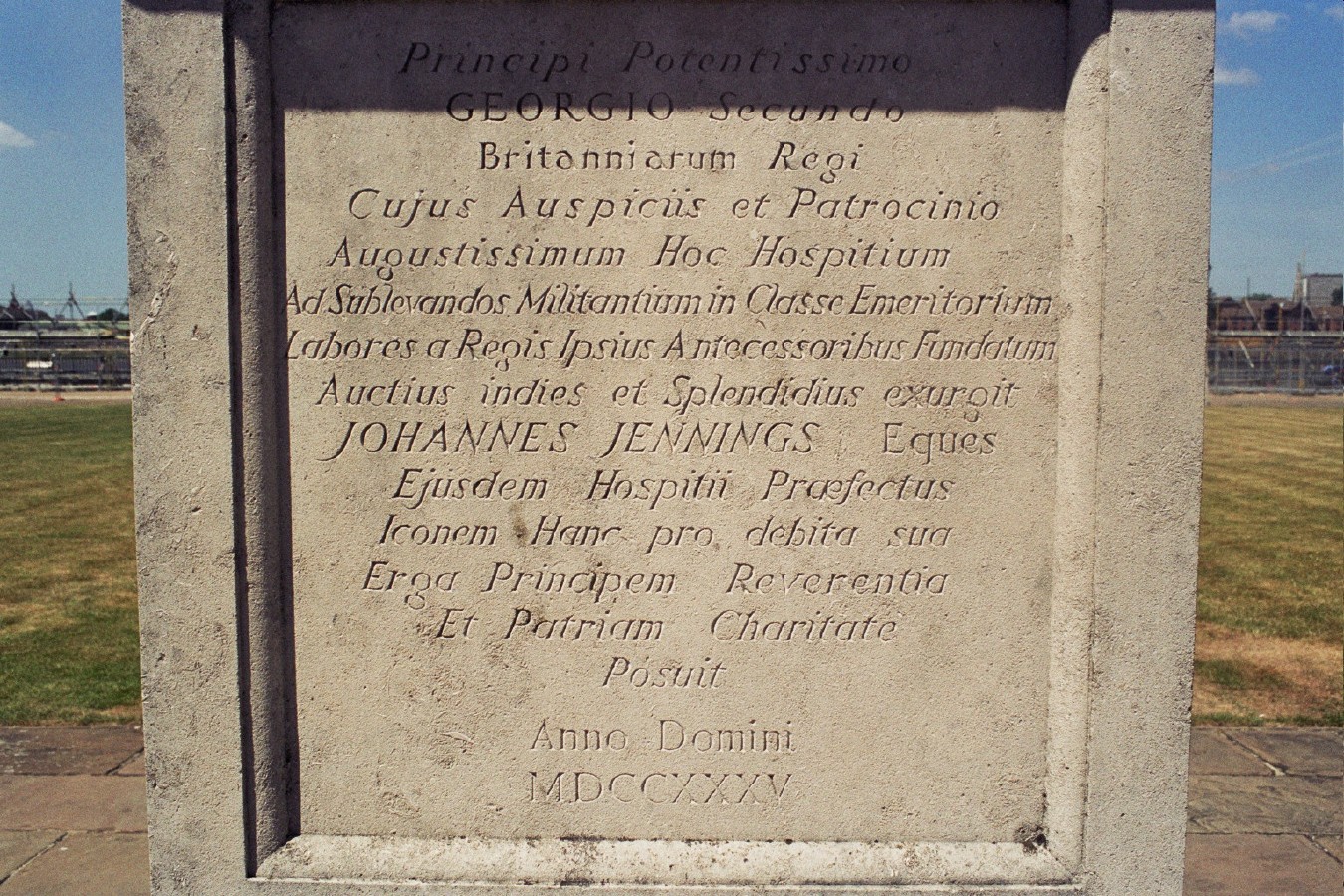Three Further Examples of Statues of George II.
George II.
Michael Rysbrack.
Old Royal Naval Hospital.
Greenwich.

Image courtesy the Welcome Library

Image courtesy the Welcome Library.
_________________________________
The Inscription on the pedestal.


{On the south face of plinth:}
PRINCIPI POTENTISSIMO
GEORGIO SECUNDO
BRITANNIARUM REGI
CUJUS AUSPICIIS ET PATROCINIO
AUGUSTISSIMUM HOC HOSPITIUM
AD SUBLEVANDOS MILITANTIUM IN CLASSE EMERITORIUM
LABORES A REGIS IPSIUS ANTECESSORIBUS FUNDATUM
AUCTIUS IN DIES ET SPLENDIDIUS EX(S)URGIT
JOHANNES JENNINGS EQUES
EJUSDEM HOSPITII PRAEFECTUS
ICONEM HANC PRO DEBITA SUA
ERGA PRINCIPEM REVERENTIA
ET PATRIAM CHARITATE
POSUIT
ANNO DOMINI
MDCCXXXV
{“To the almighty emperor, King George II of
Britain, under whose direction and patronage this magnificent hospital,
established by the king’s own predecessors to alleviate the burdens of retired
seamen, is rising up, expanding and becoming more splendid every day. Sir John Jennings, governor of the same
establishment, placed this image in due reverence for the King and for the love
of his country in the year of our Lord 1735.”}
{On the east face of plinth:}
HIC REQUIES SENECTAE
HIS MODUS LASSO MARIS ET VIARUM
MILITIAEQ(UE)
{“Here is a rest for old age, an end for someone who
is tired of sailing the seas and fighting.”
From Horace’s Odes (Book 2 Part 6).}
{On the plinth, north (river) face:}
HIC AMES DICI PATER ATQ(UE) PRINCEPS
{“Here may you delight in being called our father
and prince” From Horace’s Odes (Book 1 Part 2) and was originally addressed to
Emperor Augustus.}
{relief carving of the Royal Standard 1714-1801}
IMPERIUM
PELAGI
{“The dominion of the sea”}
{On the west face of plinth:}
FESSOS TUTO PLACIDISSIMA PORTU ACCIPIT
{“This most peaceful place welcomes those who are
weary to its safe haven.” From Virgil’s
Aeneid (Book 3 Chapter 4).}
This translation from http://www.londonremembers.com/memorials/george-ii-statue-at-greenwich
_______________________________
Statue of George II, on the King's Pillar,.
by an anonymous sculptor perhaps Michael Rysbrack
Stowe House, Buckinghamshire.
The King's Pillar is a monument to George II, It
consists of a Corinthian column over 30 feet high topped by a statue over seven
feet high of George in his state robes. The monument was erected by Lord Cobham
in 1724, when George was still Prince of Wales, and it was originally located just to the south of the Great Cross
Walk, one of the major avenues in the garden layout of Charles Bridgeman and
Sir John Vanbrugh.
The King's Pillar remained in place until 1840, when
it was taken down and the statue moved north of the house. The statue was sold
in 1921.
In the Stowe sales of the 1920's most of the statuary at Stowe was sold. Surprisingly, both George I and Princess Caroline survived.
The statue of Princess Caroline and the equestrian King George I were restored in 1992 as a part of the English Heritage grant programme.
George II, however, was bought by Sir Phillip Sassoon, and now forms an integral part of the wonderful garden at Port Lympne.
Another version of the copy of this statue was recently on the market.
After 160
years, a replacement King's Pillar is now back in the place of the original in the
garden. The National Trust completed this project during the summer of 2004.
Originally, the monument to his wife, Queen
Caroline, was also nearby: downhill and to his left, in a small theatre and
surrounded by statues of shepherds and shepherdesses. She and her entourage
also faced the Rotunda. The Queen's monument was subsequently moved in the
1760's to the west side of the Home Park on the original site of the Belvedere,
or Temple of Fame, where it still stands. The reflecting pool that lay between
the Queen's monument and the Rotunda was filled in at that time.
The King's Pillar bears this inscription from
Horace's Ode 15, Book IV:
GEORGIO AUGUSTO.
Crevere Vires, Famaque & Imperi
Porrecta Majestas ad ortum
Solis ab Hesperio Cubili
Custode rerum Cæsare-----
The Seeley Guidebooks provide the following
translation of the above:
Under the care of Cæsar's scepter'd hand,
With strength and fame increas'd, this favour'd Land
The Majesty of her vast Empire spread,
From the Sun rising to his Western bed.
This translation, and the way in which the quotation
is lifted out of the context of the rest of the ode, obscure an underlying
concern of Horace's about Augustus Caesar (and perhaps a similar concern of the
Temple family about George II). While the Latin name and the power of Italy
have increased in size, Horace says, the dignity and the reputation of the
government have been laid low. The power of Caesar is shown in contrast to the
ideals of the Roman Republic, a tension that reappears a number of times throughout
the garden.
The National Trust reported.
The present owner has
kindly allowed the National Trust to make a cast of the statue in reconstituted
Portland stone, and this is funded by the Trust's continuing Stowe Statues
Appeal. It is not known what happened to the original pedestal and pillar, but
from the diameter of the cornice found by the archaeologist, one can calculate
the height of the original column with the use of classical rules. The restored
pedestal, column, and statue measure 13.5 meters.
___________________________________
George II.
probably John van Nost III.
This statue has been attributed to Benjamin Rackstrow of the Strand but I remain sceptical.
Lead.
Destroyed 1937.
Formerly on The Weavers Hall, The Coombe, Dublin.
This is my particular favourite.
see my blog post for much fuller details of this statue
http://english18thcenturyportraitsculpture.blogspot.co.uk/2016/09/george-ii-weavers-hall-dublin.html





